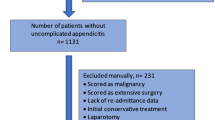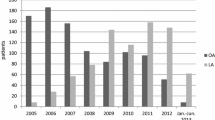Abstract
Background
Laparoscopic appendectomy (LA) has obtained wide acceptance over the last two decades. However, some studies suggest that there is an increased rate of intraabdominal abscess (IAA) when is compared with open appendectomy. Since postoperative IAA is associated with high morbidity, identifying predictive factors of this complication may help to prevent it. The aim of this study was to identify preoperative and intraoperative risk factors for IAA after LA.
Methods
From January 2005 to June 2015, all charts of consecutive patients underwent to LA were revised. Demographics, clinical and intraoperative variables were analyzed. Independent risk factors for postoperative IAA were determined by logistic regression analysis.
Results
A total of 1300 LA were performed. The mean age was 34.7 (14–94) years. Two hundred and twenty-five patients (17.3%) had complicated appendicitis with perforation and peritonitis. The conversion rate was 2.3% (30 cases). The average hospital stay was 1.6 (0–27) days. There were 30 (2.3%) postoperative IAA. In the multivariate analysis, body mass index (BMI) >30 (p 0.01), leukocytosis >20,000/mm3 (p 0.02), perforated appendicitis (p < 0.001) and operative time >90 min (p 0.04) were associated with the development of postoperative IAA. There was no mortality in the series.
Conclusion
Patients with obesity, leukocytosis >20,000/mm3, perforated appendicitis and surgical time longer than 90 min have a higher chance of having a postoperative IAA. A close postoperative follow-up would be necessary in these situations in order to prevent and identify IAA after LA.
Similar content being viewed by others
References
Buckius MT, McGrath B, Monk J et al (2012) Changing epidemiology of acute appendicitis in the United States: study period 1993–2008. J Surg Res 175(2):185–190
Addiss DG, Shaffer N, Fowler BS et al (1990) The epidemiology of appendicitis and appendectomy in the United States. Am J Epidemiol 132:910–925
Sauerland S, Lefering R, Neugebauer EA (2002) Laparoscopic versus open surgery for suspected appendicitis. Cochrane Database Syst Rev 1:CD001546
Kathouda N, Mason RJ, Towfigh S et al (2005) Laparoscopic versus open appendectomy: a prospective randomized double blind study. Ann Surg 242:439–448
Galli R, Banz V, Fenner H et al (2013) Laparoscopic approach in perforated appendicitis: increased incidence of surgical site infection? Surg Endosc 27(8):2928–2933
Asarias JR, Schlussel AT, Cafasso DE et al (2011) Incidence of postoperative intraabdominal abscesses in open versus laparoscopic appendectomies. Surg Endosc 25:2678–2683
Reid RI, Dobbs BR, Frizelle FA (1999) Risk factors for post-appendicectomy intra-abdominal abscess. Aust N Z J Surg 69(5):373–374
MacKellar A, MacKay AJ (1998) Wound and intraperitoneal infection following appendectomy for perforated or gangrenous appendicitis. Aust N Z J Surg 56:489–491
Gupta R, Sample C, Bamehriz F et al (2006) Infectious complications following laparoscopic appendectomy. Can J Surg 49(6):397–400
Alvarado A (1986) A practical score for the early diagnosis of acute appendicitis. Ann Emerg Med 15(5):557–564
Dindo D, Demartines N, Clavien PA (2004) Classification of surgical complications: a new proposal with evaluation in a cohort of 6336 patients and results of a survey. Ann Surg 240(2):205–213
Markides G, Subar D, Riyad K (2010) Laparoscopic versus open appendectomy in adults with complicated appendicitis: systematic review and meta-analysis. World J Surg 34(9):2026–2040. doi:10.1007/s00268-010-0669-z
Asarias JR, Schlussel AT, Cafasso DE et al (2011) Incidence of postoperative intraabdominal abscesses in open versus laparoscopic appendectomies. Surg Endosc 25(8):2678–2683
Xiao Y, Shi G, Zhang J et al (2015) Surgical site infection after laparoscopic and open appendectomy: a multicenter large consecutive cohort study. Surg Endosc 29(6):1384–1393
Frazee RC, Bohannon WT (1996) Laparoscopic appendectomy for complicated appendicitis. Arch Surg 131:509–511
Schmidt PJ, Hiyama DT, Swisher SG et al (1994) Analysis of risk factors of postappendectomy intra-abdominal abscess. J Am Coll Surg 179:721–726
Tang E, Ortega AE, Anthone GJ et al (1996) Intraabdominal abscesses following laparoscopic and open appendectomies. Surg Endosc 10:327–328
Serralta A, Planells M, Bueno J et al (2000) A simple scoring system to reduce intraabdominal septic complications after laparoscopic appendectomy. Surg Endosc 14:1028–1030
Gupta N, Machado-Aranda D, Bennett K et al (2013) Identification of preoperative risk factors associated with the conversion of laparoscopic to open appendectomies. Int Surg 98(4):334–339
Plannels MV, Garcìa Espinosa R, López Martínez C et al (1997) Factores predictivos de complicaciones sépticas en la apendicetomía laparoscópica. Cir Esp 62:380–385
Elgart J, Pfirter G, Gonzalez L et al (2010) Obesity in Argentina: epidemiology, morbimortality and economic impact. Rev Argent Salud Pública 1(5):6–12
Ogden CL, Carroll MD, Curtin LR et al (2006) Prevalence of overweight and obesity in the United States, 1999–2004. JAMA 295:1549–1555
Varela JE, Hinojosa MW, Nguyen NT (2008) Laparoscopy should be the approach of choice for acute appendicitis in the morbidly obese. Am J Surg 196:218–222
Towfigh S, Chen F, Katkhouda N et al (2008) Obesity should not influence the management of appendicitis. Surg Endosc 22(12):2601–2605
Fraser JD, Aguayo P, Sharp SW et al (2010) Physiologic predictors of postoperative abscess in children with perforated appendicitis: subset analysis from a prospective randomized trial. Surgery 147(5):729–732
St Peter SD, Adibe OO, Iqbal CW et al (2012) Irrigation versus suction alone during laparoscopic appendectomy for perforated appendicitis: a prospective randomized trial. Ann Surg 256(4):581–585
Cho J, Park I, Lee D et al (2015) Risk factors for postoperative intra-abdominal abscess after laparoscopic appendectomy: analysis for consecutive 1,817 experiences. Dig Surg 32(5):375–381
Snow HA, Choi JM, Cheng MW et al (2016) Irrigation versus suction alone during laparoscopic appendectomy; A randomized controlled equivalence trial. Int J Surg 28:91–96
Author information
Authors and Affiliations
Corresponding author
Ethics declarations
Conflict of interest
Drs. Schlottmann, Sadava, Peña and Rotholtz have no conflicts of interests or financial ties to disclosure.
Rights and permissions
About this article
Cite this article
Schlottmann, F., Sadava, E.E., Peña, M.E. et al. Laparoscopic Appendectomy: Risk Factors for Postoperative Intraabdominal Abscess. World J Surg 41, 1254–1258 (2017). https://doi.org/10.1007/s00268-017-3869-y
Published:
Issue Date:
DOI: https://doi.org/10.1007/s00268-017-3869-y




